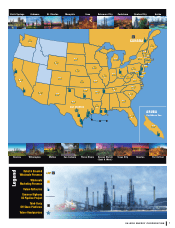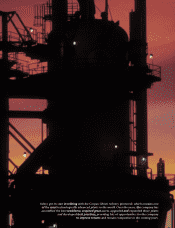Valero 2006 Annual Report Download - page 13
Download and view the complete annual report
Please find page 13 of the 2006 Valero annual report below. You can navigate through the pages in the report by either clicking on the pages listed below, or by using the keyword search tool below to find specific information within the annual report.
VA L E R O E N E R G Y C O R P OR AT I O N 11
Developing One of the World’s
Most Complex Refining Systems
Valero’s refining system isn’t just
the biggest in North America, it’s
stretches back to the beginning of the
company – to plan for a future that
would belong to companies with the
ability to process lower-cost heavy,
sour feedstocks into premium, clean-
burning fuels. That strategy has paid
off for Valero ever since 1984, when
it entered the refining business by
commissioning its Corpus Christi
refinery.
To keep its competitive advantage over
other refiners, Valero has acquired
facilities and upgraded them to meet
this strategy. For example, the Port
Arthur refinery – part of the Premcor
acquisition in 2005 – became Valero’s
most profitable plant in 2006, and
including expansions through the first
quarter of 2007, it has added 325,000
barrels per day (BPD) of medium
and heavy sour feedstocks to Valero’s
capacity.
Today, Valero has more catalytic
cracking capacity than some refining
companies’ total conversion capacity.
The same is true of Valero’s coking
capacity. Sour crude oil and residual
fuels make up approximately
60 percent of Valero’s raw materials
input, which provides tremendous
cost advantages. As the world moves
toward cleaner fuel standards, the
demand for easy-to-process light,
sweet crude is growing. Meanwhile,
the long-term trend for most new
oil being produced to meet rising
worldwide demand typically has
been heavier and more sour, and not
number of different heavy, sour and
resid feedstocks that Valero processes
has grown from 27 in 2002 to 40 in
2006. Because Valero is able to choose
from a wide selection of feedstocks,
the company can ensure that it’s
getting the best prices the marketplace
is offering.
And with Valero’s large throughput
capacity, changes in price differentials
rapidly add up. Every $1 difference
between sweet and sour crude oils
impacts Valero by about $500 million
per year in operating income.
Internal projects to add conversion
capacity have given Valero even more
of a competitive advantage. A new
hydrocracker reactor at the Ardmore
refinery in 2006 should contribute
an additional $10 million to $12
million to the refinery’s 2007 operating
income, and in 2007 new mild
hydrocracking units at the Houston
and St. Charles refineries should boost
the company’s conversion capacity
even higher.
Valero’s strategy was forward-
thinking when it was adopted in the
early 1980s. Today, because of its
tremendous complexity and flexibility,
the company’s refining system is
considered to be one of the very best
in the world.
Resid
Maya
Arab
Light/Medium
2002 2003 2004 2005 2006
$5
$0
$10
$15
$20
$25
Continued Wide Differentials
Valero’s ability to
process a wide
variety of feedstocks
allows it to quickly
take advantage of
price differentials
in the marketplace
and mitigate supply
disruptions.
all refiners are as well-positioned as
Valero to process those grades of
crude oil. As those trends continue,
the difference in price between heavy
or sour crude oil and more costly
light, sweet crude oil should remain
favorable.
As a result of the company’s focus on
increasing feedstock flexibility, the
also one of the most complex. This is
a result of Valero’s strategy – which
























